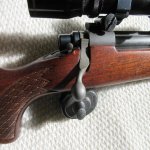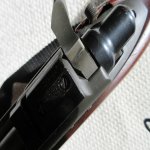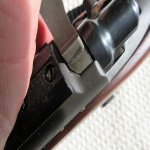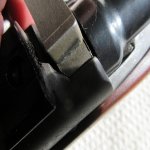And a silver solder joint like this is STRONG; probably very nearly as strong as a good welding job and stronger than a poor one. This issue with Remingtons and the lack of primary extraction is more and more common. I have one in the shop where the handle never does even touch the camming surface and the dimensions of the handle are such that, even with moving the handle as much as possible, extraction is still poor. Their quality contol people are either blind or just stupid.
You are using an out of date browser. It may not display this or other websites correctly.
You should upgrade or use an alternative browser.
You should upgrade or use an alternative browser.
700 bolt with no initial extraction cam
- Thread starter guntech
- Start date
And a silver solder joint like this is STRONG; probably very nearly as strong as a good welding job and stronger than a poor one. This issue with Remingtons and the lack of primary extraction is more and more common. I have one in the shop where the handle never does even touch the camming surface and the dimensions of the handle are such that, even with moving the handle as much as possible, extraction is still poor. Their quality contol people are either blind or just stupid.
Yes Bill it's sad to see stuff like this from the factory. I had to remove metal from the front of the handle, everywhere except the camming surface in order to get it ahead enough...
Here is my jig. Diemaker's bolt with 1/2-13 threads to screw into the bolt body. Three scraps of 1/4-20 threaded rod, a bit of steel and a couple of nuts.
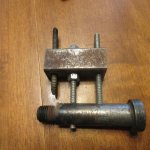
Assembled with bolt body and bolt handle:
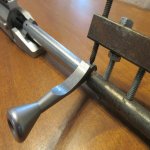
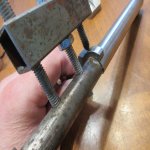
Note that the jigged up assembly can still be installed in the receiver, so that it can be confirmed that the timing is correct. The lugs are in the lugways, and the stop shoulder on the bolt handle is contacting the lower edge of the lugway. The front clamp screw and rear jackscrew are pulled up hard. The handle won't shift when heat is applied. In use, the bolt from the lugs almost back to the jig would be wrapped in wet rags. The saddle and adjoining area of the bolt body has to reach red heat. The diemaker's bolt screwed into the body acts as a heat sink.
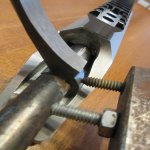
And here is a jig that is priceless if you are doing bolt handle work like cutting and welding, etc. Brownells jig, this one is the old model.
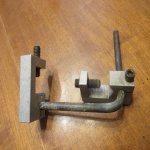

Assembled with bolt body and bolt handle:


Note that the jigged up assembly can still be installed in the receiver, so that it can be confirmed that the timing is correct. The lugs are in the lugways, and the stop shoulder on the bolt handle is contacting the lower edge of the lugway. The front clamp screw and rear jackscrew are pulled up hard. The handle won't shift when heat is applied. In use, the bolt from the lugs almost back to the jig would be wrapped in wet rags. The saddle and adjoining area of the bolt body has to reach red heat. The diemaker's bolt screwed into the body acts as a heat sink.

And here is a jig that is priceless if you are doing bolt handle work like cutting and welding, etc. Brownells jig, this one is the old model.

Attachments
Attachments
- Location
- Western Manitoba
Question for Tiriaq about that jig you built - have been looking for similar for soldering on front sight to barrel - since yours works well, somehow it keeps the bolt handle positioned and in place as the solder beneath goes liquid? What, if anything, do you do to "tighten" it as the solder melts?
Using the paste silver/flux combination, I have not found it necessary to tighten it while hot. I clamp it firmly, this keeps enough tension that nothing shifts. With sheet silver, it might be necessary. Little Vicegrip on the rear jackscrew would do the trick.
If the handle were to move, it would be necessary to start over.
Brownells sells a front sight ramp jig that is spring loaded.
If the handle were to move, it would be necessary to start over.
Brownells sells a front sight ramp jig that is spring loaded.
When you study knocked off handles, on many it is apparent that the factory induction braze joint had far less than 100% coverage. That contributes to failure.
Most of the ones I worked on were in the North, where rifles tend to be rode hard and put away wet.
Hard extraction was often the result of a pitted chamber.
Another problem was rust forming in the bolt sleeve threads, preventing the bolt from rotating to unlock.
Instead of 2x4s, rocks or hammers may have been used. The bottom of the bolt knob would often show signs of having been beaten on.
I remember one 700, where the handle had been hammered. The saddle started to peel off the bolt body, bending as it went, and then it snapped. I didn't have a replacement handle, so I had to detach the remaining stump of the saddle, correct the curve of the other piece, steel weld them together, refit the handle to the bolt, and silver solder it on. Worked OK.
788s and 700s weren't the only ones with detached handles - I saw Mausers as well. And that is a one piece bolt.
Most of the ones I worked on were in the North, where rifles tend to be rode hard and put away wet.
Hard extraction was often the result of a pitted chamber.
Another problem was rust forming in the bolt sleeve threads, preventing the bolt from rotating to unlock.
Instead of 2x4s, rocks or hammers may have been used. The bottom of the bolt knob would often show signs of having been beaten on.
I remember one 700, where the handle had been hammered. The saddle started to peel off the bolt body, bending as it went, and then it snapped. I didn't have a replacement handle, so I had to detach the remaining stump of the saddle, correct the curve of the other piece, steel weld them together, refit the handle to the bolt, and silver solder it on. Worked OK.
788s and 700s weren't the only ones with detached handles - I saw Mausers as well. And that is a one piece bolt.
To whom it may concern-
Any Remington 2 lug bolt & handle depending on vintage is .080" to .180" out of TIME.
Fwd & Aft positioning that I refer to as LOCATION is only 1 part of the 5 part equation to TIME a bolt & handle.
721/722/40X vintage bolt handles are of straight/perpendicular round knob design of Long cam & the proverbial ding/divot/burred configuration once used.
4,5,6,7,A,B,C,D,E,F,S,TT bolt handles are of the Long Cam as I've coined them & will have the proverbial ding/divot/burr pushed up from the drafted extraction cam angle that does not match the receiver's drafted primary extraction angle.
Current production RR prefix serial numbered receivers have the re-designed JUNK Short Cam handles as I've coined them & are physically & mechanically impossible to TIME w/o re-working.
Any,but not all "G" & 3rd gen S/S receivers of 2006 vintage w/ the introduction of the X Mark trigger groups are the ODD ball receivers that have a .010"-.012" step to RH side of the receiver primary extraction cam surface &/or in the bottom fwd corner of the bolt handle cut..if present the step(s) need to be blended out w/ a needle file or LOCATION is effected.
If your only option is brazing-match the components-wire to flux as not to mix brands/manufacturers.
Cadmium type silver braze gives you wetting/capillary action to raise the grain for a superior attachment.
Non cadmium silver braze though safer for the installer is as useless as tits on a fish.
Not my first Rodeo!
Any Remington 2 lug bolt & handle depending on vintage is .080" to .180" out of TIME.
Fwd & Aft positioning that I refer to as LOCATION is only 1 part of the 5 part equation to TIME a bolt & handle.
721/722/40X vintage bolt handles are of straight/perpendicular round knob design of Long cam & the proverbial ding/divot/burred configuration once used.
4,5,6,7,A,B,C,D,E,F,S,TT bolt handles are of the Long Cam as I've coined them & will have the proverbial ding/divot/burr pushed up from the drafted extraction cam angle that does not match the receiver's drafted primary extraction angle.
Current production RR prefix serial numbered receivers have the re-designed JUNK Short Cam handles as I've coined them & are physically & mechanically impossible to TIME w/o re-working.
Any,but not all "G" & 3rd gen S/S receivers of 2006 vintage w/ the introduction of the X Mark trigger groups are the ODD ball receivers that have a .010"-.012" step to RH side of the receiver primary extraction cam surface &/or in the bottom fwd corner of the bolt handle cut..if present the step(s) need to be blended out w/ a needle file or LOCATION is effected.
If your only option is brazing-match the components-wire to flux as not to mix brands/manufacturers.
Cadmium type silver braze gives you wetting/capillary action to raise the grain for a superior attachment.
Non cadmium silver braze though safer for the installer is as useless as tits on a fish.
Not my first Rodeo!
The biggest variable of any Remington 2 lug bolt is-
The length of the bolt body "TUBE"
Of which,the bolt lugs/head is pinned(3/16" diam) 1/2" aft of the RH bolt lug(RH bolt) & then induction silver brazed.
The handle installer,installs the aft end of the handle flush w/ the aft end of the bolt body "TUBE" & then induction silver brazes the handle on.
Both induction operations take less than 2 seconds to accomplish that brazing task.
The length of the bolt body "TUBE"
Of which,the bolt lugs/head is pinned(3/16" diam) 1/2" aft of the RH bolt lug(RH bolt) & then induction silver brazed.
The handle installer,installs the aft end of the handle flush w/ the aft end of the bolt body "TUBE" & then induction silver brazes the handle on.
Both induction operations take less than 2 seconds to accomplish that brazing task.
Here is one I am repairing for a friend. Custom single shot precision rifle action made in 1998. Handle failed in 2019. Currently in 7mmWSM, load was a bit warm, extraction was a bit hard, handle separated. To get the bolt body out, I had to pull the barrel. Remington type, but not a Remington bolt. Over the years, a lot of rounds were fired.
View attachment 362790
Note that the silver solder covers less than half the saddle. Amazing it held as long as it did.
View attachment 362791
Receiver is composite. Aluminum body, with steel inserts at the front for the barrel threads and locking abutments, and a steel insert for extraction camming.
View attachment 362792
View attachment 362793
Cone nosed bolt.
View attachment 362794
The action.
View attachment 362796
that looks like a Panda receiver
Dragon-Rifles
New member
- Location
- Quesnel BC
Thanks for this break down Dan.
it is nice to read from people who now the difference between silver brazing and lower temperature silver soldering ( which is really mostly Tin with a small bit of silver in the solder like Brownells Hi-force 44.)
Good info Guntech and tiriaq
I bet most of the broken off 700 bolts were beaten off with a 2x4 because they had inadequate primary extraction in the first place.
Well, I had to beat the bolt handle open more than once on my 700 when I first started reloading back in the early 80's and it had nothing to do with primary extraction....




















































